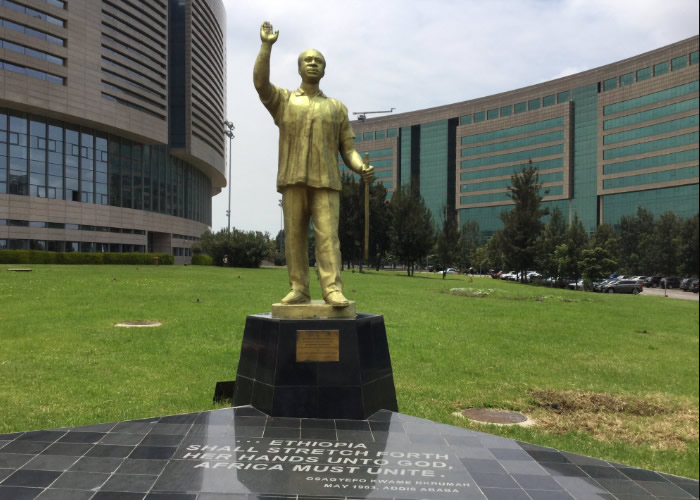‘Discoverer, Seeker, Finder/Founder?’
- Home
- ‘Discoverer, Seeker, Finder/Founder?’

‘Discoverer, Seeker, Finder/Founder?’
It was at the Jomo Kenyatta International Airport, Nairobi, Kenya in early 2017, from where I was flying to Addis Ababa, Ethiopia.
As part of the Handing /Taking Over the process, my predecessor was going with me to the African Union Headquarters in Ethiopia to introduce me as the new CEO, African Peace Support Trainers Association (APSTA,) headquartered in Nairobi, Kenya.
As the Immigration Officer inspected my passport, he suddenly yelled with excitement “Oooow, you are from Ghana! Osagyefo’s Ghana! Kwame Nkrumah (pronounced “Nim-krew-mah”) of Ghana and Africa! The African of the last Millennium! Ghana is a great country……!”
Saturday, September 21, 2024, marked the 115th anniversary of the birth of Osagyefo.
Osagyefo
Having led Ghana to independence on March 6, 1957, Osagyefo made that famous statement:
“The independence of Ghana is meaningless unless it is liked with the total liberation of the continent of Africa!”
He, thus, declared his Pan-Africanist vision/intentions. With independence, Osagyefo became the first Prime Minister of Ghana while the Queen of England continued to be Ghana’s head of state. Nkrumah, therefore, continued to fight for Ghana’s sovereignty as a fully-fledged nation. On July 1, 1960, Ghana became a Republic, with Osagyefo Dr Kwame Nkrumah as its first president.
The celebration of Osagyefo’s 115th birthday was low-key. However, on a Joy TV programme on the morning of September 21, 2024, retired Air Force Pilot Wing Commander (Wg Cdr) Patrick Sorgbordjor gave an interesting and highly educative account of Ghana’s political history and Nkrumah’s role from his arrival in the Gold Coast in November 1947.
The visionary, charismatic and selfless leader that he was, Osagyefo was admired but also hated in equal measure for different reasons. For example, while the general drift among politicians in the 1950s was for the independence of the Gold Coast to be in gradual incremental steps, Osagyefo came out with “Self-Government Now!”
This led to his breaking away from the United Gold Coast Convention (UGCC) to form his Convention People’s Party (CPP) to fast-track his objective of immediate independence.
Ghana National College
In 1948, Nkrumah gave a foretaste of his radical approach to Gold Coast’s independence. Following the killing of Sgt Adjetey, Cpl Attipoe and Pte Odartey-Lamptey during the 1948 Christiansborg Riots/Shooting, he and five others, called the “Big Six” were arrested.
Their arrest sparked student demonstrations in some second-cycle institutions in Cape Coast, which demanded their release. The Quashie-Idun Commission, which investigated the protests, recommended the expulsion of the students and some teachers.
A total of 150 students from Mfantsipim School and St Augustine’s College, and four teachers, three from St Augustine’s and one from Mfantsipim, were expelled. The teachers were Mr Kwesi Plange, Mr J.J. Mensah-Kane, Mr H.P. Nelson and Mr H.W.K. Sackeyfio (Mfantsipim), later Col Sackeyfio of the Ghana Armed Forces.
Providing a personal “seed money” of ten pounds, Nkrumah on July 16, 1948, established the Ghana National College, with a nucleus of the four sacked teachers and 16 students.
So, the name Ghana was used in 1948 by Nkrumah long before he christened the Gold Coast Ghana in 1957.
Education & Industrialisation
Realising the need for an educated citizenry for his plan for Ghana’s industrial development, Osagyefo established the Ghana Education Trust (GET) Secondary Schools to augment the few Missionary Schools at Independence.
They include Mfantsiman, Ofori Panin, Techiman, Winneba, Swedru, Apam, Dormaa, Tema, Oda and Labone Secondary Schools.
He also established training colleges to train teachers. Some are the Atebubu Training College, Berekum Training College, Fosu Training College, Enchi Training College, Kwadaso College of Education and the School of Languages in Ajumako.
Perhaps, the icing on Osagyefo’s educational cake was the establishment of the University College of Cape Coast (now University of Cape Coast in December 1962.
In his quest to propel Ghana into a middle-income country from a raw-material-producing nation, Osagyefo established many import-substituting factories. Some are the Aboso Glass Factory, Bonsa Tyre Factory at Tarkwa, Akasanoma Electronics Factory-Tema, Kade Match Factory, Saltpond Ceramics, Kumasi Jute Factory, Asutsuare Sugar Factory, Bolgatanga Meat Processing Factory, Wenchi Tomato Factory and Akosombo Textiles.
His vision also resulted in the building of the Akosombo Dam and Accra Tema Motorway.
Discussion
Seen as a threat to their economic interests in Ghana and Africa, Nkrumah was loathed by the West for his Pan-Africanism, though they could not dispute his charisma and greatness. His book, “Africa Must Unite”, was particularly frightening/offensive to them.
Some acknowledgements of his greatness include a bronze statue in front of the African Union Headquarters in Addis Ababa, Ethiopia. Similarly, there is a monument of him in Cuba. In Maputo, Mozambique, there is a street Avenida (Avenue) Kwame Nkrumah. Streets are also named after him in Nairobi Kenya, Conakry Guinea and Kampala Uganda.
In the US, there is a bust of him displayed at the Schomburg Centre for Research in Black Culture in New York. Similarly, there is a bust of Osagyefo in the Martin Luther King Library in Washington DC.
If only Ghanaian leaders would learn from Nkrumah’s selflessness, commitment and love for Ghana, the self-destruction of galamsey would not be happening, such that a Chinese ambassador can tell Ghanaians to blame ourselves for the mess we are in. For those burning energy vilifying Nkrumah, remember evil never wins! Oliver Cromwell is only remembered by the British as a villain for the murder of King Charles I in 1649.
Despite being hated by both the West and some Ghanaians, Osagyefo’s legacy continues. In the Daily Graphic of Friday, September 27, 2024, veteran writer Enimil Ashon stated as follows:
“Last Saturday, September 21, after over 40 years of advocacy, pleas, threats, legal wrangling in court, often daggers drawn between Old Students and the Nsein Traditional Council, Kwame Nkrumah finally got his name back on a school he built.
The coup makers of February 24, 1966, burnt Nkrumah’s books and removed his name from all institutions named after him. What they did not factor in the futility of their thinking was one fact of human life, that in this world, you can’t burn knowledge, nor bury a name.
Today, Nkrumsco is back. I am referring to the momentous occasion, last weekend, when the Paramount Chief of the Nsein Traditional Area joined hands with Old Students to inaugurate the renaming of the school from Nsein SHS back to Kwame Nkrumah SHS.”
Even though Osagyefo died on April 27, 1972, in Rumania at age 62, the flame he lit not only for Ghana but for Africa continues to burn brightly, hence his being declared the “African of the Millennium.”
Leadership, Lead by Example! Fellow Ghanaians, WAKE UP!
The writer is a former CEO, African Peace Support Trainers Association, Nairobi, Kenya and Council Chairman of Family Health University College, Teshie, Accra
Email: dkfrimpong@yahoo.com
Source: graphic.com.gh
- Share
Classic Ghana
Classic Ghana brings you into a fun world of arts, entertainment, fashion, beauty, photography, culture and all things in between. Let’s explore these together!







